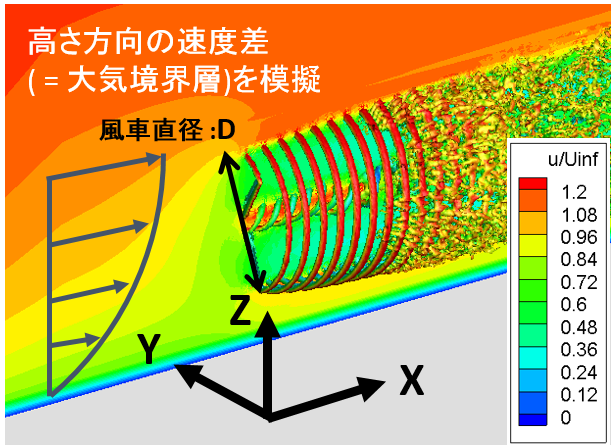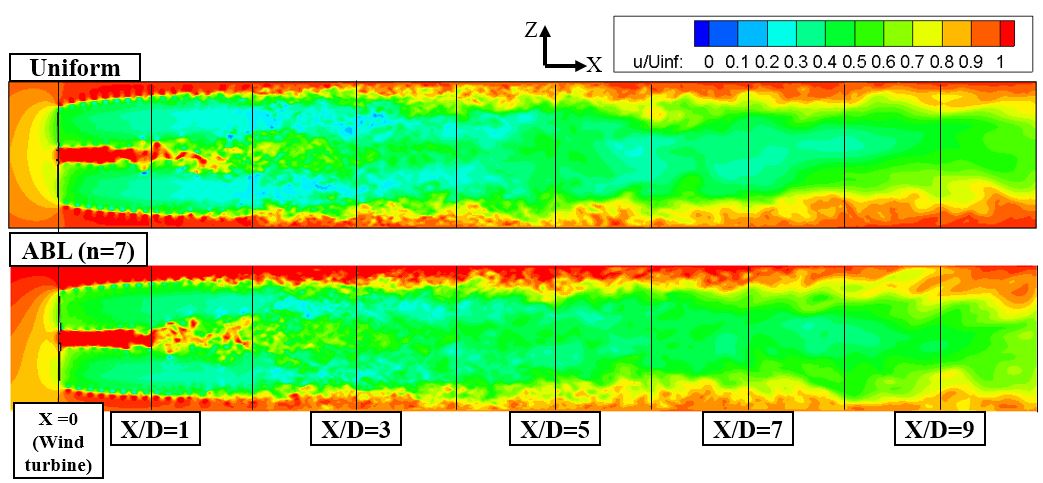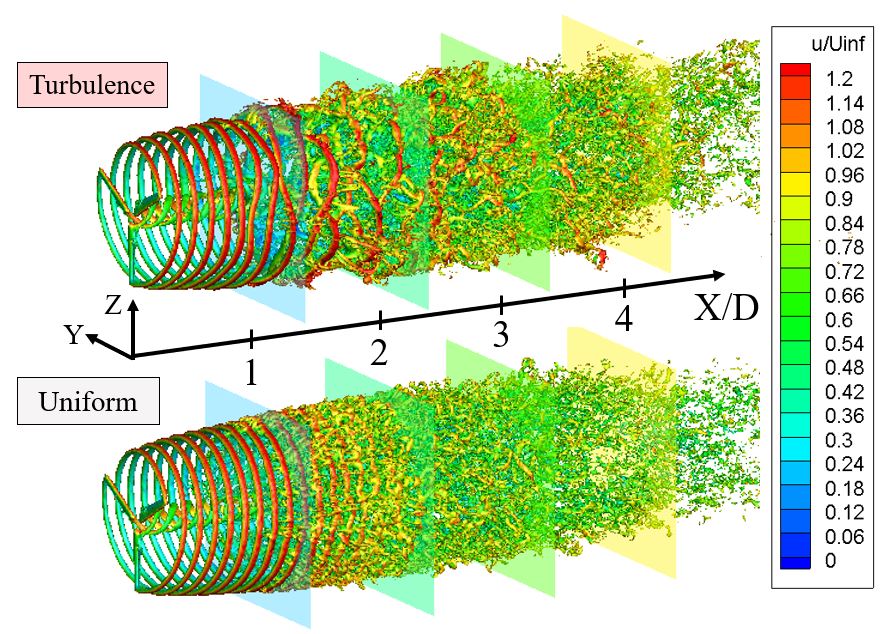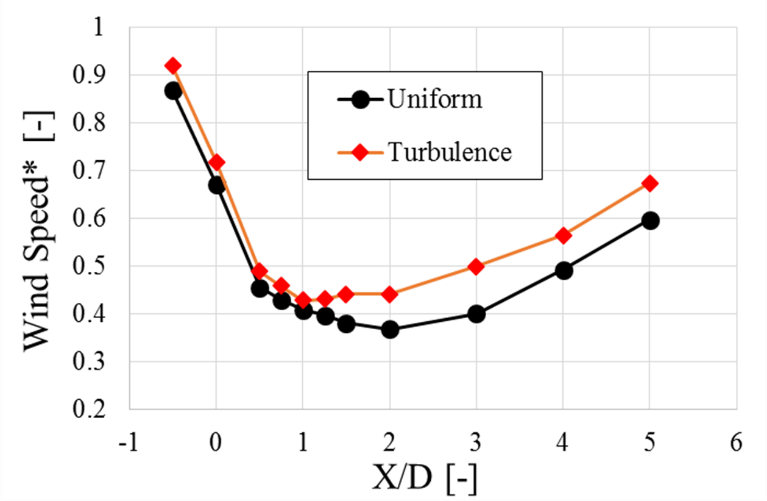CFD analysis of wind turbine wake
JAXA Supercomputer System Annual Report April 2017-March 2018
Report Number: R17ETET09
Subject Category: Skills Acquisition System
- Responsible Representative: Yasutada Tanabe, Aeronautical Technology Directorate, Next Generation Aeronautical Innovation Hub Center
- Contact Information: Keita Kimura k.kimura@ilab.eco.rcast.u-tokyo.ac.jp
- Members: Keita Kimura, Yasutada Tanabe, Yousuke Shinozaki
Abstract
In a large wind farm (arrays of wind turbines), wind turbine wake can cause power deficits or/and additional fatigue in turbine stands in wake region. In this study, several wake simulations were performed to obtain the characteristics of wind profiles in wind turbine wakes. These information can be used for design of wind farm. In this year, we focused on the effect of the properties of natural wind, such as wind shear and wind fluctuation.
Reference URL
N/A
Reasons for using JSS2
In order to resolve the detail structure of wind turbine wake, computational domain should extends to about 10 rotor diameters downwind. On the other hand, to resolve the fluctuations from rotational blades, grid scales need to be the order of chord length of blade tips. As a result, it is necessary to put large computational grid which has high grid resolution. Thanks to JSS2, such simulations of high computational cost can be performed.
Achievements of the Year
In this year, two inflow conditions were generated to model the characteristics of natural wind. One of them is the atmospheric boundary layer (ABL) conditon whose inflow speed varies with height above ground (wind shear), and the other is atmospheric turbulence condition whose inflow has specified fluctuations. By using such conditions, we investigated effects of natural wind on the wind speeds in wake regions. As the results of the velocity deficit in wake region, the effect of wind shear is not strong in far-wake region. On the other hand, the atmospheric turbulence condition accelerates the recovery of wind speed by causing dynamic mixing of tip vortices.
Publications
■ Peer-reviewed papers
1) Keita Kimura, Yasutada Tanabe, Takashi Aoyama, Yuichi Matsuo, Chuichi Arakawa, and Makoto Iida, “CFD simulations of a wind turbine for analysis of tip vortex breakdown,” Journal of Physics: Conference Series, 749 (2016) 012013, 2016
■ Non peer-reviewed papers
1)Yosuke Shinozaki, Yasutada Tanabe, Takashi Aoyama, Yuichi Matsuo, Chuichi Arakawa, Hirofumi Daiguji, and Makoto Iida, “A Study on Spreading Wakes by Wind Turbine Wake Simulation,” Nagare, 36(6), pp.403-408, 2017.
■ Presentations
1)Yosuke Shinozaki, Yasutada Tanabe, Takashi Aoyama, Yuichi Matsuo, Chuichi Arakawa, and Makoto Iida, “Effect of tip vortex release cycle on wind turbine wake”,
49th Fluid Dynamics Conference/35th Aerospace Numerical Simulation Symposium, Tokyo, 2017.
2)Yosuke Shinozaki, Yasutada Tanabe, Takashi Aoyama, Yuichi Matsuo, Chuichi Arakawa, Hirofumi Daiguji, Makoto Iida, “A Study on Spreading Wakes by Wind Turbine Wake Simulation”, Annual meeting of Japan Society of Fluid Mechanics2017, Tokyo, pp.1-6, 2017.
3)Yousuke Shinozaki, Yasutada Tanabe, Takashi Aoyama, Yuichi Matsuo, Chuichi Arakawa, and Makoto Iida, “Dependent characteristic of tip vortex release cycle on energy recovery in wind turbine wake”, The Japan Society of Mechanical Engineers annual meeting, 17(1), Saitama, J0540206, 2017.
4)Yosuke Shinozaki, Yasutada Tanabe, Takashi Aoyama, Yuichi Matsuo, Chuichi Arakawa, Hirofumi Daiguji, Makoto Iida, “Dependent characteristics of tip vortices on kinetic energy transition in wind turbine wakes”, WindEurope Conference & Exhibition 2017, Amsterdam, PO153, 2017.
5) Keita Kimura, Yasutada Tanabe, Takashi Aoyama, Yuichi Matsuo, Chuichi Arakawa, and Makoto Iida, “Evaluation of wind turbine wake simulation focusing on grid resolution”, WWEC 2016, Tokyo, Japan, October, 2016.
6)Keita Kimura, Yasutada Tanabe, Takashi Aoyama, Yuichi Matsuo, Chuichi Arakawa, and Makoto Iida, “CFD analysis of the effect of Atmospheric Boundary Layer on wind turbine wake”, AHS 73rd Forum, #28, Texas, USA, May, 2017.
7)Keita Kimura, Yasutada Tanabe, Takashi Aoyama, Yuichi Matsuo, Chuichi Arakawa, and Makoto Iida,”Dependency of tip speed ratio for tip vortex decay around wind turbine blade”, 49th Fluid Dynamics Conference/35th Aerospace Numerical Simulation Symposium, 1B08, Tokyo,2017.
8)Keita Kimura, Yasutada Tanabe, Takashi Aoyama, Yuichi Matsuo, Chuichi Arakawa, and Makoto Iida, “Numerical study of wake flow mixing in turbulence condition”, WindEUROPE Conference&Exhibition2017, Amsterdam, Netherlands, November, 2017.
9)Keita Kimura, Yasutada Tanabe, Takashi Aoyama, Yuichi Matsuo,and Makoto Iida, “Numerical analysis of wind distributions in wind turbine wake”, 39th Japan Wind Energy Symposium, Tokyo, 2017.
Usage of JSS2
Computational Information
- Process Parallelization Methods: MPI
- Thread Parallelization Methods: OpenMP
- Number of Processes: 2 – 8
- Elapsed Time per Case: 1,000.00 hours
Resources Used
Fraction of Usage in Total Resources*1(%): 0.75
Details
Please refer to System Configuration of JSS2 for the system configuration and major specifications of JSS2.
| System Name | Amount of Core Time(core x hours) | Fraction of Usage*2(%) |
|---|---|---|
| SORA-MA | 561,986.58 | 0.08 |
| SORA-PP | 1,028,549.46 | 12.88 |
| SORA-LM | 0.09 | 0.00 |
| SORA-TPP | 0.00 | 0.00 |
| File System Name | Storage Assigned(GiB) | Fraction of Usage*2(%) |
|---|---|---|
| /home | 096.56 | 0.07 |
| /data | 10,986.33 | 0.20 |
| /ltmp | 2,197.27 | 0.17 |
| Archiver Name | Storage Used(TiB) | Fraction of Usage*2(%) |
|---|---|---|
| J-SPACE | 0.00 | 0.00 |
*1: Fraction of Usage in Total Resources: Weighted average of three resource types (Computing, File System, and Archiver).
*2: Fraction of Usage:Percentage of usage relative to each resource used in one year.
JAXA Supercomputer System Annual Report April 2017-March 2018






